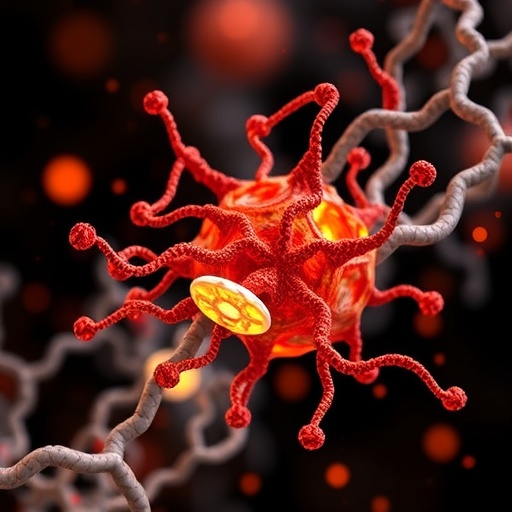Mitochondria are indispensable organelles within eukaryotic cells, renowned for their critical role in harnessing the energy necessary to sustain biological functions. These cellular powerhouses execute oxidative phosphorylation, a process that converts nutrients into adenosine triphosphate (ATP), the universal energy currency of the cell. However, their role transcends mere energy conversion as mitochondria must dynamically modulate their activity in response to fluctuating cellular energy demands. Despite the recognition that nutrient availability influences mitochondrial function, the precise molecular mechanisms orchestrating this metabolic adaptation have eluded comprehensive understanding—until now.
In a groundbreaking study led by Professor Dr. Thorsten Hoppe at the University of Cologne’s Institute for Genetics and the CECAD Cluster of Excellence on Aging Research, researchers have unveiled a novel biochemical pathway elucidating how the essential amino acid leucine directly modulates mitochondrial respiration. Published in Nature Cell Biology, their research delineates how leucine enhances mitochondrial efficiency by stabilizing specific proteins on the outer mitochondrial membrane, thereby augmenting cellular energy production. This discovery reveals a sophisticated nutrient-sensing mechanism that links dietary inputs with mitochondrial bioenergetics at a molecular level.
Leucine is one of the branched-chain amino acids (BCAAs), characterized by its essentiality for humans—that is, its requirement through dietary intake as opposed to endogenous synthesis. It is abundant in proteinaceous foods such as dairy products, red meats, and legumes. The study reveals that leucine exerts its influence by preventing the proteasomal degradation of a subset of mitochondrial surface proteins responsible for importing metabolic substrates and cofactors essential for ATP generation. This preservation of mitochondrial membrane integrity ensures optimal import and electron transport chain activity, culminating in heightened mitochondrial respiration rates.
The team’s investigations uncovered that leucine modulates the levels of SEL1L, a protein integral to the endoplasmic reticulum-associated degradation (ERAD) quality control machinery. Typically, SEL1L collaborates in recognizing and targeting damaged or misfolded proteins for degradation—a cellular housekeeping mechanism vital for proteostasis. However, leucine downregulates SEL1L’s activity in relation to mitochondrial proteins, thereby attenuating the degradation of outer mitochondrial membrane constituents. This downregulation effectively aids in maintaining mitochondrial function under conditions of nutrient abundance by allowing the accumulation of critical protein complexes.
Dr. Qiaochu Li, the study’s first author, remarks on the physiological implications, noting that this leucine-SEL1L regulatory axis allows cells to swiftly recalibrate energy production to match fluctuating metabolic demands. When nutrient conditions are favorable, cells can enhance mitochondrial output, optimizing bioenergetic capacity for growth, proliferation, or other energy-intensive activities. This paradigm highlights how macronutrient availability signals adaptively reorganize intracellular bioenergetic pathways.
Exploring the broader biological context, the researchers employed the model organism Caenorhabditis elegans to examine the systemic impacts of disrupted leucine metabolism. Their findings revealed that impairments in leucine catabolism adversely affect mitochondrial function, manifesting in phenotypes such as reduced fertility. Given the evolutionary conservation of mitochondrial function and protein quality control, these findings underscore the critical nature of amino acid homeostasis in whole-organism vitality and reproduction.
Extending their research to human cellular models, specifically lung cancer cells, the investigators observed that mutations influencing leucine metabolism confer a survival advantage to malignant cells. This insight implicates mitochondrial nutrient sensing in oncogenesis and tumor maintenance, suggesting that cancer cells exploit leucine-mediated pathways to augment energy production and sustain unchecked proliferation. This revelation opens a promising avenue for therapeutic intervention targeting metabolic vulnerabilities in cancer.
Notwithstanding the therapeutic potential, the study cautions against indiscriminate manipulation of the leucine-SEL1L axis. Given SEL1L’s fundamental role in safeguarding protein quality, chronic suppression could permit accumulation of dysfunctional proteins, potentially precipitating mitochondrial and cellular dysfunction over time. Thus, any clinical strategies must carefully balance the enhancement of mitochondrial efficiency against the imperative of maintaining proteostasis.
From a metabolic regulation standpoint, this research integrates the fields of nutrient sensing, protein quality control, and mitochondrial biology, providing a comprehensive view of how dietary components influence cellular energy machinery. It suggests that beyond caloric content, the qualitative nature of nutrients, such as amino acid composition, critically shapes mitochondrial physiology through finely tuned biochemical pathways.
Furthermore, the study underscores the interplay between nutrition and aging. Mitochondrial dysfunction is a hallmark of age-related diseases and degenerative disorders. By elucidating how leucine stabilizes mitochondrial proteins, the findings suggest potential dietary or pharmacological interventions that could ameliorate mitochondrial decline associated with aging, thus promoting healthy longevity.
The implications of this discovery also extend into the field of metabolic disorders. Considering that impaired mitochondrial function contributes to pathologies such as diabetes and obesity, understanding the leucine-mediated modulation of mitochondrial proteins could illuminate novel metabolic targets. These insights may facilitate development of approaches aimed at restoring or enhancing mitochondrial performance in metabolic disease contexts.
In sum, the University of Cologne research provides compelling evidence that nutrient availability, specifically leucine, exerts a direct regulatory effect on mitochondrial protein stability and function via the modulation of the SEL1L protein. This finding significantly advances our understanding of cellular bioenergetics and nutrient adaptation, with expansive ramifications across health, disease, and metabolic regulation. Future research will undoubtedly explore how these mechanistic insights translate into clinical therapies and nutritional strategies aimed at optimizing mitochondrial health.
This research was facilitated through funding by Germany’s Excellence Strategy under the auspices of CECAD, the German Research Foundation’s Collaborative Research Centres, the European Research Council Advanced Grant program, and the Alexander von Humboldt Foundation, highlighting the collaborative and international effort underpinning this scientific breakthrough.
Subject of Research: Animals
Article Title: Leucine inhibits degradation of outer mitochondrial membrane proteins to adapt mitochondrial respiration
News Publication Date: 31-Oct-2025
Web References: 10.1038/s41556-025-01799-3
Image Credits: Qiaochu Li | University of Cologne
Keywords: Mitochondria, Leucine, SEL1L, Protein Degradation, Energy Metabolism, Mitochondrial Respiration, Nutrient Sensing, Cellular Bioenergetics, Protein Quality Control, Cancer Metabolism, Aging, Metabolic Disorders
Tags: biochemical pathways in energy metabolismbranched-chain amino acids and healthdietary influence on mitochondrial efficiencyessential amino acids and cellular energyimpact of leucine on bioenergeticsleucine and mitochondrial energy productionmitochondrial dynamics and energy demandsmolecular mechanisms of mitochondrial respirationnutrient sensing in mitochondrial functionoxidative phosphorylation and ATP synthesisprotein stabilization in mitochondriarole of mitochondria in cellular metabolism





